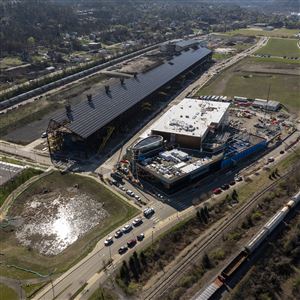Each air monitoring site for fine particulate pollution in Allegheny County met all federal standards in 2013, a first since monitoring began in 1999 and an accomplishment county Executive Rich Fitzgerald and the Health Department said they were proud to announce Friday.
"Today was a good milestone to celebrate, and realize that we can achieve what was thought to be a very difficult task," said Jim Thompson, deputy director of environmental health for the county health department.
But both health officials, as well as area environmental groups, said a good deal of work remains to improve air quality in the region.
"Of course, we are always glad to hear that air quality is improving," said Tom Hoffman, Western Pennsylvania director for Clean Water Action. "That's an important thing."
Still, he referenced a report released in November by a center at the University of Pittsburgh Graduate School of Public Health, which said Allegheny County residents have a higher cancer risk due to air pollutants. And he pointed to reports that the Shenango coke works on Neville Island had one or more air violations on 330 days in a 432-day period over 2012 and 2013.
"I don't think it's fair to say that the air, particularly in the Liberty-Clairton area, is healthy yet," he said.
Liberty is the location of what has long been the "problem monitor," as Mr. Thompson put it, since it is downwind of what he called a "very large air pollution source," U.S. Steel's Clairton coke plant.
"It's also the river valley there, tends to trap the pollution that's there," he said. "Both of those factors make that area very challenging in terms of air pollution control."
The current U.S. Environmental Protection Agency standard for fine particulate pollutants, or PM2.5, is 12 micrograms per cubic meter. The 24-hour standard is 35.
The Health Department's eight air monitoring sites met both standards in 2013.
At the Liberty site, historically the worst for air quality, the annual average in 2013 was 12 micrograms and the 24-hour average was 31.1, with lower concentrations measured at the seven other sites in Avalon, Clairton, North Braddock, Harrison, Lawrenceville, North Park and South Fayette, which were already in attainment.
Mr. Thompson said that in recent years air pollution has been addressed through actions such as U.S. Steel investing in new coke batteries and low-emission quench towers at its Clairton site.
Courtney A. Boone, a spokeswoman for U.S. Steel, said the company was pleased by the air quality improvements, and said the company is "committed to continuing on this path forward."
Elsewhere in the county, Mr. Thompsons said changes such as the switch from coal to natural gas at the Bellefield Boiler plant in Oakland and the addition of scrubbers to the stacks at Bay Valley Foods on the North Side reduced the fine particulate matter being released into the air.
Upwind of the county, in places such as the Ohio Valley, air quality help has come from power plants switching from coal-fired to natural gas, he said.
"It's been a lot of hard work, both here locally, but also nationally, to make sure that the upwind pollution is not affecting us as much," he said.
PM2.5 levels are a concern locally and nationally.
"They're pretty much linked to anything negative you can think of for health concerns," such as cardiovascular disease and cancer rates, said Jamin Bogi, policy and outreach director for the Group Against Smog and Pollution, or GASP
He, too, called the 2013 data for the Liberty air monitor "great news," but cautioned that it was only one year, and that differences in factors ranging from weather to the economy could cause the monitor to exceed standard levels again.
"We know that a lot of factors affect air pollution," he said.
To be in attainment of federal air quality standards by the EPA's 2020 deadline, the county must post three consecutive years of data showing each of its air quality monitors are at or below PM2.5 standards, which means the Liberty monitor must have good news the next two years.
Although the county's announcement Friday was about air monitors measuring fine particulate matter, the department has other air monitors for different types of air pollution.
A separate air monitor in Liberty has not yet reached the federal standard for sulfur dioxide levels, and the county has also not attained standard levels for ozone measurements at its three ozone monitors, Mr. Thompson said.
Kaitlynn Riely: kriely@post-gazette.com or 412-263-1707.
First Published: March 14, 2014, 3:36 p.m.
Updated: March 15, 2014, 4:02 a.m.















